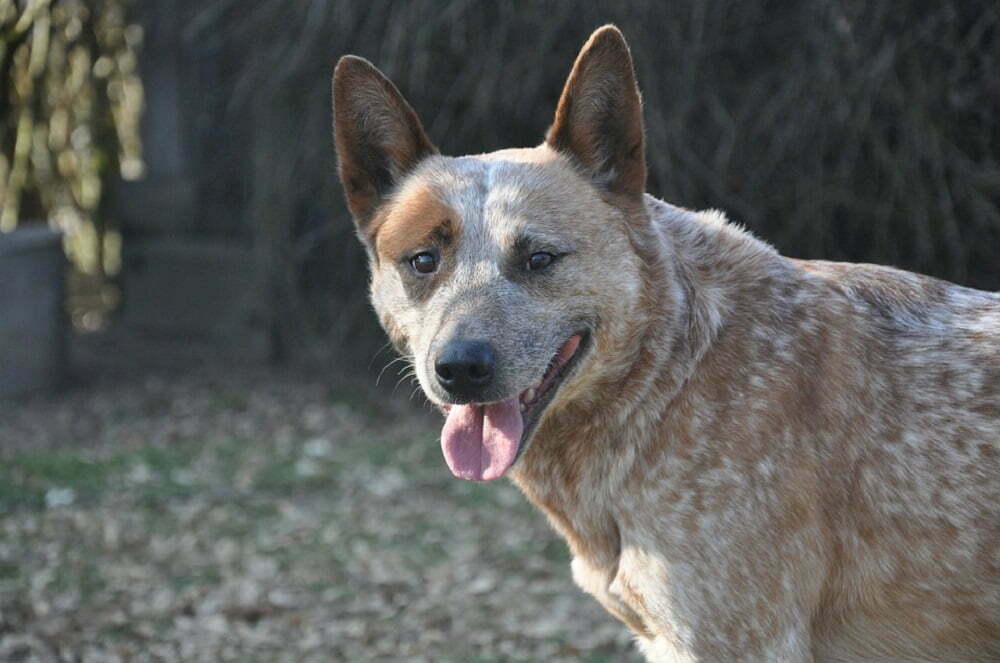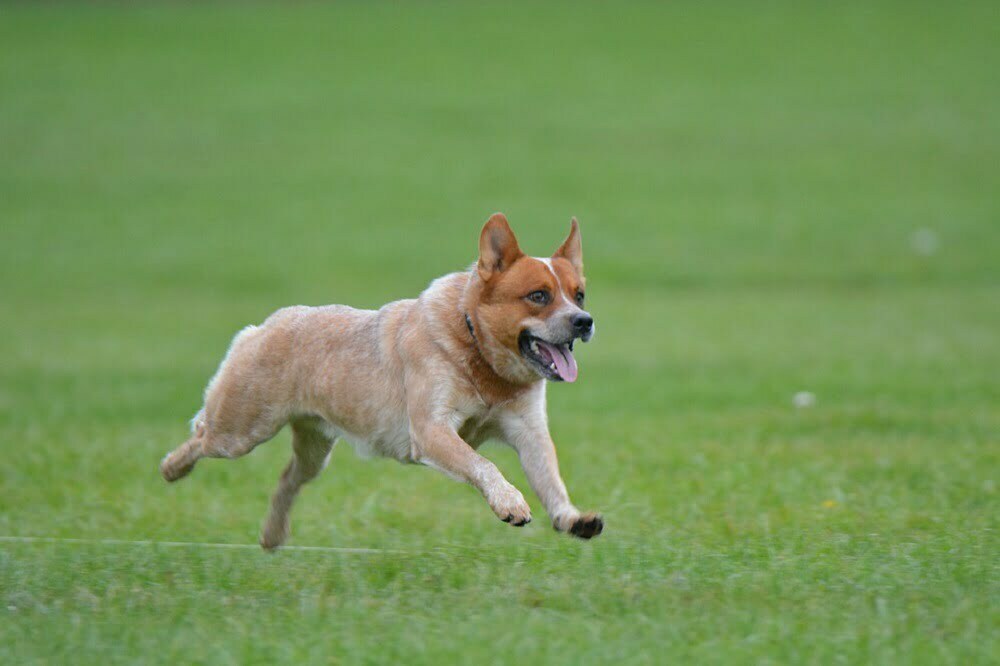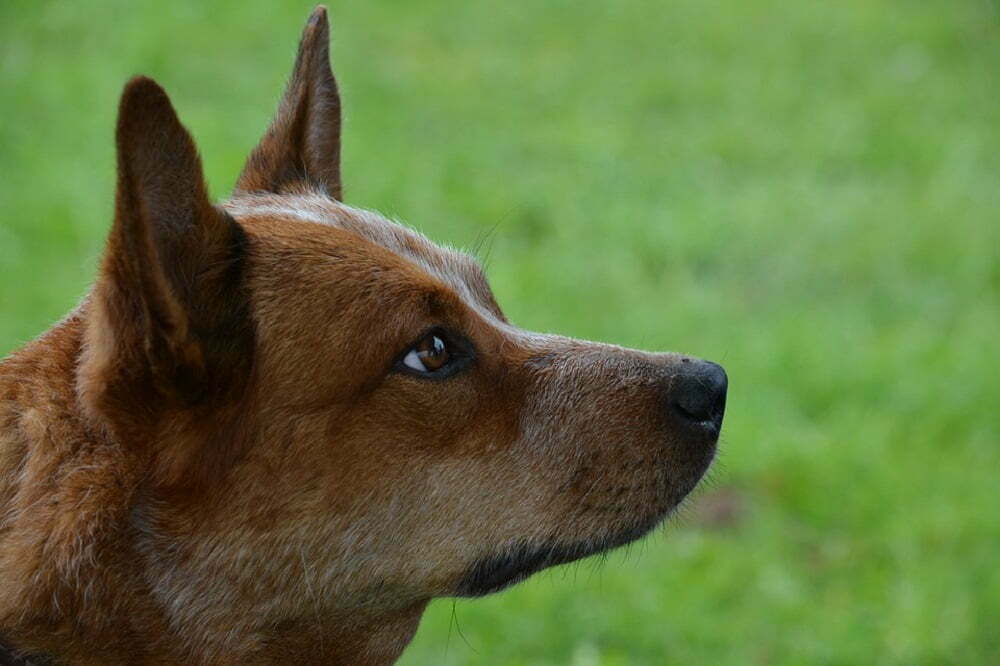The Affectionate Dog with Dingo Blood Coursing Through its Veins
Bred by Australian settlers to help with herding duties, the Australian cattle dog is a task-oriented firecracker of a canine that loves as hard as it works.
Positively brimming with energy and joie de vivre, this wonderfully intelligent dog may be just the fluffy life partner you need to complete your family unit.

Key Facts
Average Lifespan
Australian cattle dogs, or ACD if you’re looking to save a second or two, typically have a lifespan of between 13 and 15 years, longer than the 10 to 13-year average for dogs in general — talk about staying power!
Minimum Exercise (Per Day)
One of the most agile dogs on the planet, they get a kick out of challenging physical activity, so warm up your Frisbee arm, folks. These majestic wolfies require a minimum of 2 hours exercise per day, so they’re not for the faint of heart.
They love walkies to the park, but as their ancestors drove cattle for long distances over challenging terrain, they also love a long hike or mountain excursion.
Coat Length
Their coats are fairly short, measuring 2.4 to 4cm in length, depending on the area. ACD’s have what’s known as breeching, which means the fur grows longer on their underbody and around their thighs.
Their coat is also thicker and longer around the tail and neck, but their front legs, head, ears, and feet all have short hair.
As a breed with a working heritage, the ACD has a classic, weather-resistant double coat made up of slightly longer, straight guard hairs, and a short, dense undercoat.
Minimum Cost (Per Month)
On average, bringing an ACD into your home will set you back around $2250 for the first year, which equates to $225 a month — yikes, am I right? However, that is an average estimate. Shopping smart will likely bring that cost down by $100 or so.
From the second year onwards, annual costs shrink to roughly $1370, which divides into monthly fees of $114, but again, that’s the average. The minimum amount you can scrape by is probably a little less than this figure.
Appearance
Size
Australian cattle dogs are decidedly medium-sized woofers, which makes them the perfect size to have on the couch next to you or snoozing at the end of your bed. Not too big, and not too small, they’re also very car-friendly.
Average Height
The average male ACD will grow to between 18 and 20 inches tall, and full-grown females can reach anywhere between 17 and 19 inches tall. It takes between 12 and 18 months for them to reach full physical maturity.
Average Weight
The average weight of a full-grown, male ACD ranges from 15 to 16kg, and strangely, females can weigh as much as 16kg too, but they may also weigh as little as 14kg.
Temperament
Apartment Living
With the vast open plains of Australia in their DNA, ACDs typically don’t adapt well to apartment living, although their natural agility means they can navigate smaller spaces quite well.
With plenty of training and a large enough living space, moving an Australian cattle dog into an apartment is possible, and in the hands of a confident and knowledgeable owner, they make for great city dwellers too, but it’s not their favorite environment.
Good for Novice Owners
The Australian cattle dog is pretty much out of the question for novice dog owners, even if they have an ideal living situation to accommodate one. Due to their exercise requirements and demanding personalities, looking after an ACD is incredibly hard work.
These little fellas need tons of physical challenges, so you have to have some decent walking boots primed and ready to go when you bring one into your home. As a novice owner, you’d also have to fork out for outsourced training, and being that an ACD will perpetually try to assert their dominance, staying firm and establishing yourself as the leader of the pack is essential — something new owners have trouble with.
Sensitivity Level
Being that the Australian cattle dog has big old brains, it’s no surprise that they’re also very sensitive creatures with deep, human-like emotions. They don’t care for major routine overhauls, and they’re receptive to mood, so it’s best to keep family feuds out of sight and earshot.
Tolerates Being Alone
Australian cattle dogs bond quite closely with their family, so they get a little worried when you’re not around. They can be on their own for a little while, but as a rule of thumb, you should try and make it back to your home as quickly as possible.
An ACD won’t handle a full 8-hour workday on their own cooped up in the house, so if you’re a busy professional, it’s probably not the right breed for you. When left to their own devices for too long, they tend to get bored, which is inevitably followed by destructive episodes, so say goodbye to all your favorite socks and slippers.
Tolerates Cold Weather
Hailing from the scorching farmlands of Australia, you’d be forgiven for thinking that the ACD is more of a warm-weather pooch, but that’s not the whole truth. That luscious double coat keeps the ACD from shivering when the temperature plummets during the winter months.
It’s not just a slight chill they can handle, either. These hardy canines can weather sub-freezing temperatures with no problems at all.
Tolerates Hot Weather
Okay, so…that means that they’re cold-weather dogs, right? Wrong again, I’m afraid. Despite that double coat, they’re just as energetic and hard-working in hot climates. Dealing with intense heat is hardwired into their genetic code, but they will of course need plenty of water to stay hydrated, and a nice shady cool spot for relaxing after a day of running their owner ragged.
Affectionate with Family
If not properly socialized, ACDs can easily become 1-person dogs, but when properly prepared for family life, they’re some of the most affectionate dogs in the world, so I hope you’re ready for lots of sloppy kisses and big fluffy hugs.
They may work hard during the day, but at night, they love nothing more than snuggling up with you in bed and slinging some well-earned ZZZs.
Kid-Friendly
Australian cattle dogs aren’t especially happy to be around kids, but as long as they’re aware that they’re part of the pack, they’re not particularly bothered by them. As such, it’s best to bring an ACD into the household after establishing your family unit rather than beforehand.
However, even if an ACD accepts a child as part of the household, it’s not the best situation. As these dogs are so sensitive, the volume of a baby or young child can be detrimental to their mental well-being.
Dog-Friendly
For the most part, ACDs are perfectly happy to be around other dogs, especially if they’ve been raised together in the same household; however, as they love so completely, they can also become quite jealous if another dog gets attention from its favorite humans.
The only reason an Australian cattle dog would be timid or aggressive towards its fellow canines is if it was never properly socialized in infancy.
Friendly Towards Strangers
Australian cattle dogs don’t really vibe with strangers. Their loyalty to the family is so strong that they become wary of outsiders, which often manifests as a reservedness in their presence.
This distrust of unfamiliar faces can intensify if they haven’t been properly socialized, causing their wariness to build into full-blown suspicion.
They need to be enthusiastically introduced to happy, friendly people from a young age so that they learn that there’s a difference between good and bad strangers.
Health and Grooming

Shedding
While Australian cattle dogs shed a surprising amount for their short coats, they’re considered relatively average shedders overall.
Unfortunately, their short, coarse hairs are notoriously difficult to strip from clothing, carpets, and furniture, so you’ll need to invest in something like this pet hair remover.
They shed mildly year-round until fall and spring when they start blowing their winter coats. During these periods, they’ll shed clumps upon clumps of hair in preparation for the cooler months.
Grooming
ACDs don’t require tons of fuss in the grooming department. Your schedule will include daily teeth brushing, the odd bath, a few nail trimming sessions, and brushing once a week with a slicker brush.
That said, when they start blowing their coat come spring and fall, you’ll need to brush them two or three times a week, otherwise, you risk being buried alive in fluff.
Drooling
The germaphobes out there will be happy to hear that the Australian cattle dog barely drools at all, so don’t shy away from hugs; accept them wholeheartedly and enjoy the moisture-free embrace!
General Health
Australian cattle dogs are tough as old boots and boast immaculate general health. They’re by no means a sickly or weak breed, on the contrary, they’re vivacious and muscular.
Common Health Problems
As is the case with every pure breed, ACDs are genetically predisposed to certain health conditions, namely deafness, eczema, hip and elbow dysplasia, PRA, and osteochondrosis dissecans.
In light of this, it’s important to have their joints, ears, and eyes tested regularly, and always keep an eye out for irritated, itchy, or inflamed skin.
Before bringing an Australian cattle dog into your home, I highly recommend that you request prescreening tests for all of these conditions from the breeder.
Potential for Weight Gain
Obesity is an issue for these dogs, especially in their golden years when they’re not getting quite as much intensive exercise as they used to.
Trainability
Easy to Train
Lovers of a challenge, these highly intelligent dogs are a dream to train. They thrive on purpose and hard work, so they find training sessions incredibly rewarding. They pick things up quickly and as they’re eager to please their owner, they have no trouble remembering and repeating what they learn.
Intelligence
Along with the border collie and German shepherd, the ACD is one of the most intelligent dogs on the planet, which means they need just as much mental stimulation as they do physical.
They must be provided with lots of doggy puzzles such as this interactive treat toy and this activity flip board. If they don’t get the stimulation they need, they’ll become bored, depressed, destructive, and clingy — an awful cocktail of canine moods.
Potential to Bite
Australian cattle dogs have a strong herding drive, and they don’t really care what it is they herd, just as long as they get the job done, which means they have a tendency to nip at things. It could be people, it could be other animals, even inanimate objects from time to time.
They’re also notorious knuckle nibblers during playtime. They don’t bite hard, but it can be irritating and a little scary if you’re not expecting it.
Even if your fluffy Aussie child has never laid eyes on a sheep or a cow, it will behave as though it’s fresh off the ranch. The work of their ancestors is embedded in their DNA; it’s just the way they are, but the good news is that they can be trained to keep the nipping to a minimum.
Tendency to Bark or Howl
All bite and no bark, Australian cattle dogs flip the old adage on its head. They’re very quiet pooches who don’t like to make a racket if they can help it. That said, if they hear another dog howling at the moon, they might try and harmonize.
History

The Australian cattle hound can be thought of as one of the first-ever designer dogs, as their origin can be traced back to a single individual with a single mission in mind.
George Hall and his family moved to Australia’s New South Wales colony in 1802. Twenty years later, the Halls had established themselves as successful cattle breeders with two stations in the upper Hunter Valley and a plan to expand northward towards the Liverpool Plains, Queensland, and New England.
Despite their success, they were faced with a conundrum. How would they drive thousands of heads of cattle thousands of kilometers over treacherous, often mountainous terrain, to the Sydney market.
At the time, he was using typical old English sheepdogs for his herding, but they were only useful over short distances, amounting to the loss of hundreds of cattle.
Hall decided enough was enough and requested that some of the finest drovers dogs from his parent’s home county of Northumberland should be purchased and imported to Australia. In the meantime, Hall got busy training a few wild dingoes, and when the drovers dogs arrived, he crossbred them.
By 1840, he’d created the hybrid dog he had been dreaming of all those years…the Australian cattle dog. With the dingo’s suitability for the environment and the work ethic of the drovers dogs, it was tailor-made to drive cattle great distances over the punishing landscape.
As dogs were often categorized by their job rather than breed, the dogs used to create the first ACDs were likely something of a random mixture of work-minded canines.
The new breed was kept in the family so as not to give competing cattle herders the same advantage Hall had created for himself, but when he passed away in 1870, his property was auctioned off, and his loyal cattle dogs were included in the sale.
It wasn’t until the 1940s that the ACD made its first appearance in the U.S., and it took 40 more years for them to reach the UK.
These days, they’re still used as cattle dogs, but their affectionate disposition has earned them a place in the hearts of families all around the world.
Costs
- ACD puppies can set you back anything between $250 and $1200. It all depends on the breeder’s reputation, pedigree, bloodline, training, medical expenses, age, coat and markings, and geographical popularity.
- The average cost of supplies for the first year of ownership is roughly $410, while following years will only set you back around $185.
- Average training costs reach $175.
- First year vet costs: $395 to $795. Spay/Neuter: $50 to $450. Adult year vet costs: $380 to $725.
- reatment fees for common health issues range from $100 to $3900 depending on the illness.
- It costs about $160 a year to feed an ACD puppy and around $210 to feed an adult.
Fun Facts
- These lovely dogs can have a red or blue coloring, and their coats can be speckled or mottled.
- Bluey, the oldest recorded dog to have ever lived, was an Australian cattle dog who reached the ripe old age of 29. That’s nearing 140 in dog years!
- ACDs are survivors! In 2009, Australian cattle dog, Sophie, was thrown overboard when her family’s boat hit a rough patch in the water. She swam 5 miles to St. Bees Island, and survived for a time on her own by hunting feral goats — now that’s letting your inner dingo out! She was eventually rescued and returned to her humans.
- ACDs are also known as heelers and their pups are born stark white.
